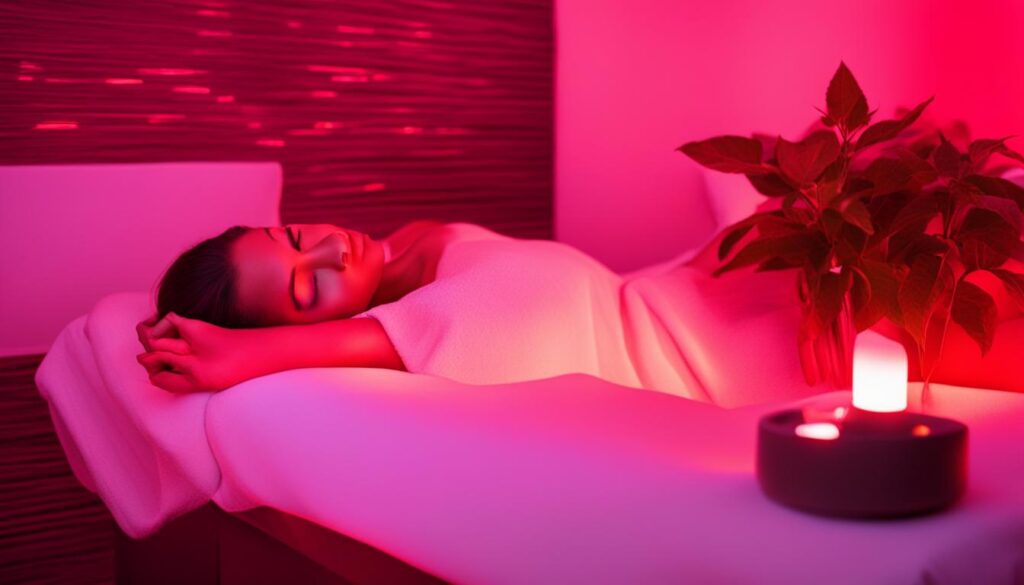If you’re considering starting a red light therapy business, you’re on the brink of tapping into a burgeoning wellness trend with significant growth potential. Photobiomodulation, commonly known as red light therapy, is breaking new ground in non-invasive health and wellness treatments. It offers an array of benefits—from pain relief and skin rejuvenation to enhance athletic performance. With a rise in people seeking natural health solutions, your decision to launch a red light therapy business could not only prove to be lucrative but deeply rewarding as well.
As you embark on this entrepreneurial journey, proper groundwork is vital. Initially, you might be overwhelmed with questions about the essential steps for starting a red light therapy business. Rest assured, diving into this industry is within reach, requiring a modest investment in equipment and infrastructure to get underway. Your business can serve a broad spectrum of clients, catering to the increasing demand in the beauty, fitness, and veterinary sectors for natural therapeutic modalities.
Key Takeaways
- Identify the rising demand for alternative therapies to guide your business strategy.
- Understand that low overhead costs can facilitate a smoother startup process.
- Recognize the versatility of red light therapy applications across multiple sectors.
- Embrace the minimal investment required for equipment and infrastructure.
- Capitalize on the growing trend of natural health solutions.
- Prepare to serve a diverse clientele seeking innovative wellness treatments.
Understanding the Appeal of Red Light Therapy
As you delve into the red light therapy business guide, it’s essential to grasp why this modality has become a cornerstone in the wellness market. More than just a trend, red light therapy offers profound health benefits that are driving its popularity.
What is Red Light Therapy?
At its core, red light therapy revolves around delivering low-level wavelengths of red and near-infrared light to the skin. Unlike ultraviolet rays, this spectrum of light is beneficial and safely interacts with human tissue at a cellular level, promoting various physiological changes.
Health Benefits and Client Demand
The health benefits of red light therapy are abundant, contributing significantly to its demand. Clients seek out these treatments to address issues ranging from chronic pain relief to skin rejuvenation, and the list continues to grow as more benefits are discovered. Pain alleviation, enhanced recovery from physical activities, and anti-aging effects are just a few of the key advantages that attract a diverse clientele to red light therapy.
- Pain Relief: Aids in reducing discomfort from conditions like arthritis and back pain.
- Skin Rejuvenation: Helps in diminishing wrinkles, scars, and signs of aging.
- Wound Healing: Accelerates the repair process of tissues and wounds.
The Science Behind Photobiomodulation
Photobiomodulation, the scientific term for red light therapy, explains how light exposure can lead to changes in cellular behavior. It’s crucial for business owners to understand and convey how this therapy stimulates mitochondria, enhances ATP production, and ultimately boosts cell regeneration and repair. By communicating the science effectively, your business can build trust and illustrate the legitimacy of the treatments offered.
Assessing Your Red Light Therapy Business Potential
Before embarking on the journey of starting a red light therapy business, it’s critical to evaluate the industry landscape and solidify your business’s foundation by identifying who your customers are and what they require. An efficient market analysis paired with a keen understanding of your target audience paves the way for a thriving enterprise. Below, you’ll discover the essential steps to jumpstart your red light therapy business and insight into pinpointing the market segments most responsive to these innovative treatments.
Market Analysis for Red Light Therapy Services
A thorough market analysis serves as your roadmap, guiding you through the intricacies of the red light therapy sector. Given the expanding awareness of wellness and self-care, people are seeking out novel ways to enhance their health without invasive procedures. This upswing spells opportunity for your business. Begin by assessing the current market size, growth projections, key competitors, and existing gaps in the marketplace.
As you analyze these facets, you’ll better understand the landscape, helping you make informed decisions and carve out your niche within the wellness community. It’s not only about knowing your competitors but also about recognizing trends and customer inclinations that could influence the demand for red light therapy.
Identifying Your Target Audience
Once you have a clear view of the marketplace, it’s time to detail your business’s target market for red light therapy. Knowing your audience is indispensable for crafting captivating and relevant service offerings. Does your ideal client seek skin rejuvenation, pain management, or enhanced athletic recovery? Are they part of the beauty sector, fitness enthusiasts, or individuals looking for holistic wellness solutions? Addressing these questions is a pivotal step in your business development.
- Consider age, gender, income levels, and lifestyle habits of your potential clients.
- Identify what makes your services unique to different client profiles within these spheres.
- Recognize their preferences, inclinations, and the factors that drive their decision-making processes.
By aligning your business approach with the needs and preferences of your target audience, you optimize your chances for success. Remember, your audience isn’t just buying a service—they are investing in an outcome, and you need to communicate why your red light therapy business is their best choice for achieving that.
Starting a Red Light Therapy Business: A Step by Step Guide
If you’re looking to break into the health and wellness industry with a cutting-edge service, red light therapy is a burgeoning field with substantial potential. Whether you’re a seasoned entrepreneur or new to the world of business, the following steps will guide you through how to start a red light therapy business step by step.
- Gain In-Depth Knowledge: Before anything else, research deeply to understand everything about red light therapy, including its therapeutic benefits, mechanisms of action, and any possible contraindications.
- Develop a Comprehensive Business Plan: Determine the scope and vision of your business. Your plan should detail your goals, target market, competition analysis, financial forecasting, and specific marketing strategies.
- Comply with Legal Requirements: Investigate and obtain all required certifications, licenses, and insurance to operate legally in your region. This will ensure compliance and instill confidence in your clientele.
- Source Quality Equipment: Invest time to choose state-of-the-art red light therapy devices that are reliable and backed by clinical evidence. This step is crucial for offering effective treatments.
- Design a Client-Friendly Space: Create a treatment environment that is comfortable and welcoming, fostering a positive experience for every client who walks through your door.
By following these tips for starting a red light therapy business, you will lay a strong foundation for a successful venture. It’s important to maintain a commitment to quality and continuous improvement, as the satisfaction of your clients will play a significant role in establishing your reputation and driving your business forward.
- Marketing is critical: Build an online presence and employ strategic advertising to reach your audience effectively.
- Customer service is key: Ensure that every interaction reflects the high standard of care and professionalism that you want your business to be known for.
- Stay informed: Keep abreast of industry trends and technological advancements to continuously enhance your services.
Embarking on this exciting journey requires diligence, patience, and an unwavering dedication to excellence. As you take these steps, remember that your efforts today are the seeds for your business’s flourishing future.
Building a Solid Red Light Therapy Business Plan
Embarking on setting up a red light therapy business begins with establishing a comprehensive plan that addresses all aspects critical to your success. Crafting a red light therapy business plan requires attention to detail, strategic thinking, and a keen understanding of the wellness market you’re about to enter.
A well-developed business plan serves as your roadmap, not only guiding you through the initial stages of establishing your business but also providing a framework for growth and the attainment of your goals. Let’s delve into the components that will construct the foundation of a robust red light therapy business plan.
- Define Your Business Objectives: Start with clear, concise goals that define what you aim to achieve with your red light therapy business.
- Conduct Market Analysis: Understand the demand in your area, assess current market trends, and identify where your services will fit in the health and wellness industry.
- Evaluate the Competition: Take a close look at existing red light therapy businesses and pinpoint how you can differentiate and position your brand.
- Develop Your Branding Strategy: Decide on how you want to present your business to potential clients and establish a brand image that resonates with them.
- Outline Services and Pricing: Determine what services you’ll offer, how they’ll be structured, and set competitive pricing models accordingly.
- Financial Planning: Create detailed financial projections including startup costs, operating expenses, revenue forecasts, and break-even analysis.
- Operational Strategies: Plan your day-to-day operations, staffing, customer service protocols, and administrative procedures.
- Funding and Partnerships: Identify potential funding sources, investor opportunities, or strategic partnerships that could provide financial support.
As you construct each section of your red light therapy business plan, remain focused on the unique aspects that will make your venture stand out. Utilize the strength of a solid plan to navigate through the complexities of the startup phase and beyond. In doing so, you lay the groundwork for a thriving business in a competitive industry, ensuring your red light therapy enterprise is poised for success from the outset.
Regulatory Compliance and Certifications
As you embark on the journey of establishing your red light therapy business, it’s imperative to understand the landscape of regulatory compliance in red light therapy and the certifications crucial for operating within the confines of the law. Not only do these regulations ensure the safety and efficacy of light therapy devices, but they also maintain industry standards that protect your business and your clients.
Navigating FDA Regulations for Light Therapy Devices
The Food and Drug Administration (FDA) oversees the use and distribution of medical devices, including those used for red light therapy. Compliance with FDA guidelines is not just a recommendation; it’s a requirement. Depending on the classification of the device you intend to use, you might need to adhere to different levels of control. Class 1 and 2 devices typically refer to general wellness products and require less stringent control, while Class 3 and 4 devices are medical-grade and necessitate proper licensing. Be vigilant about the claims your business makes regarding the efficacy of red light therapy to ensure they fall within FDA-approved cosmetic benefits unless supervised by a healthcare provider.
Understanding State-Specific Licensure and Certifications
- Research state laws and regulations governing light therapy and similar treatments to ensure you meet regional requirements.
- Recognize the need for specific certifications depending on your location, which could echo those required by establishments such as tanning salons or medical clinics.
- Stay informed about continuing education opportunities to keep your certifications for red light therapy business current and your knowledge base expansive.
Cultivating a reputable business goes hand-in-hand with compliance and credentials. Demonstrating to your clientele that you take regulatory requirements seriously instills confidence and sets you forth on a path of professional integrity and trust.
Selecting High-Quality Red Light Therapy Equipment
Embarking on the journey of starting a successful red light therapy business hinges on one critical decision: choosing the best red light therapy equipment. The equipment you invest in affects not only the efficacy of the treatments you’ll offer but also the trust clients place in your services. It’s not just about the immediate impacts, though; the longevity and reputation of your business also rest on the caliber of the equipment you utilize.

Comparing Different Types of Red Light Therapy Devices
As you navigate the market, you’ll encounter a range of red light therapy devices, each with unique features tailored to different treatment needs. LED-based panels and handheld units are popular for their consistency and broad coverage, while laser devices, though more focused, offer deeper tissue penetration. Deliberate over the pros and cons of these technologies. LED arrays typically afford pain relief and skin enhancement for a wider area, making them indispensable for aesthetic and superficial musculoskeletal treatments. On the other hand, laser devices are adept at targeting localized regions requiring intense, precise care, often ideal for deep-tissue healing.
- LED (Light Emitting Diode) Devices
- Laser Light Devices
Key Features to Look for When Purchasing Equipment
When selecting equipment to ensure the success of your red light therapy venture, pay close attention to several key attributes:
- Wavelength Range: This is the spectrum within which the device operates. It impacts the depth of skin penetration and consequently, the effectiveness of treatment.
- Power Density: Also known as irradiance, this determines the amount of light delivered to the skin per unit area and is crucial for ensuring adequate treatment intensity.
- Treatment Area Coverage: Consider the size of the area a device can treat at once, as this will affect session time and potentially, the throughput of your business.
- Build Quality: Reliability and durability are essential for long-term use and frequent operation, two factors inherent to a busy therapy practice.
- User-friendliness: Comprehensive controls and ease of use facilitate a seamless user experience for both practitioners and clients.
Remember, the longevity of red light therapy devices and the maintenance of their performance are as pivotal to your business’s success as the initial quality. Prioritize warranties and customer service in your criteria – the support a manufacturer provides can be just as important as the product itself.
Vet your options thoroughly and choose wisely; the foundation and future of your red light business could very well depend on the quality of your red light therapy equipment.
Designing an Optimal Treatment Space
When you’re setting up a treatment space for your red light therapy business, it’s more than just finding a room; it’s about creating an oasis of calm that beckons your clients into a restorative experience. The physical environment plays a significant role in the therapeutic process, and with attention to detail, your space can become inviting and effective in delivering the intended therapy benefits.
Creating a Healing Atmosphere for Clients
Consider the ambiance to be your silent ambassador of wellness. It begins with the colors on the walls, the texture of the fabrics, and even the lighting outside of the therapy area. Aim for a palette that evokes serenity and a layout that allows for effortless movement. Comfort should be paramount, which means investing in quality furnishing that helps your clients relax both before and after treatments. Details like plush towels, luxurious robes, and high-quality skincare products demonstrate your commitment to their comfort and care.
Location, Layout, and Design Considerations
Accessibility is key; your space should be easy to find and welcoming upon arrival. Once inside, the journey through your facility should be intuitive, with a clear path to the treatment areas. These spaces must be meticulously planned to not only house the red light therapy equipment but also to provide a peaceful environment that contributes to the healing process. Ensure the design can accommodate the practical aspects of therapy while appealing to the senses, thus setting the stage for a positive experience that will have your clients returning for more.
- Choose a location that’s convenient for your target demographic
- Integrate elements like soft textures, soothing colors, and tranquil sounds
- Optimize the layout for both the functionality of your treatments and the comfort of your clients
- Equip the therapy room with amenities that align with the luxurious experience you aim to provide
By mindfully creating an inviting red light therapy environment, you’re not only setting up a treatment space but also building a haven that supports the wellness journey of each individual who walks through your doors.
Effective Marketing Strategies for Your Red Light Therapy Business
As you venture into the wellness industry with your red light therapy business, crafting dynamic marketing strategies is essential. Your goal is to establish a brand that resonates with your target audience, building a robust online presence that showcases your expertise in the field of red light therapy.
Developing Your Brand and Online Presence
Brand development in the wellness industry requires a thoughtful approach that communicates the unique benefits of red light therapy. Begin by creating a visually appealing logo and a brand message that encapsulates the healing and rejuvenating qualities of your services. Your website should serve as the digital cornerstone of your brand, reflecting professionalism and providing valuable content about red light therapy benefits.
Engage with your audience through consistent, informative social media activity. Share testimonials, tips, and insights into the effectiveness of red light therapy to foster community and trust. By understanding and implementing SEO strategies, you can increase the visibility of your content, drawing more potential customers to your wellness services.
Local Marketing and Community Engagement
While developing your online brand is crucial, don’t overlook the power of local marketing and community involvement. Participate in community events, health fairs, and wellness workshops to introduce people firsthand to the benefits of red light therapy. Collaborating with local fitness studios, spas, and health practitioners can create valuable partnerships and referral networks.
- Host informational seminars to educate your community about the science and advantages of red light therapy.
- Offer special promotions and discounted packages to first-time clients to encourage trial of your services.
- Implement a referral program that rewards existing clients for bringing in new customers.
By combining a strong online presence with active community engagement, your marketing strategies for your red light therapy business will not only attract new clients but also create lasting relationships that are key for ongoing success.
Offering Exceptional Customer Experience
As a proprietor of a red light therapy business, you recognize that the heartbeat of your success lies in the delivery of an exceptional customer experience. The understanding and execution of personalized red light therapy treatments not only reflect the caliber of your services but also drastically enhance the customer experience in red light therapy. Your dedication to this principle could set the stage for lasting client relationships and a sterling reputation in the wellness market.
Staff Training and Customer Service Best Practices
Investing in comprehensive staff training equips your team with the necessary tools to offer knowledgeable and compassionate care. When your staff is adept in the science and protocols of red light therapy, they serve as confident and reliable guides for your clientele. Adherence to the best practices in customer service—including clear communication, attentiveness, and responsiveness—helps in forging a positive and lasting impression.
- Provide in-depth training on red light therapy benefits and procedures.
- Emphasize the importance of a customer-first approach in all interactions.
- Establish a continuous learning environment to keep up with industry advancements.
Tailoring Treatments to Client Needs
Your ability to customize treatments based on the unique needs of each client significantly distinguishes your service. Engaging with clients to understand their health objectives and tailor treatments to their specific conditions demonstrates a commitment to personal care that is highly valued in the health and wellness sector.
- Conduct thorough consultations to personalize the therapy experience.
- Develop treatment protocols that address individual health concerns.
- Monitor progress and adapt treatments to maximize benefits.
Ensuring these practices are at the core of your business operations will not only augment client satisfaction but also elevate your standing as a leader in the field. Remember, every detail counts when it comes to enriching the customer experience, and your focus on personalized and empathetic service will resonate with your clients long after the therapy session concludes.

Conclusion
Embarking on the journey of a red light therapy business setup signals the beginning of a promising venture in the health and wellness industry. Your success in this growing niche reflects a harmonious blend of diligent research, meticulous strategic planning, and consistent adherence to established quality and regulatory turfs. By centering your business approach on these pivotal elements, you lay a solid foundation that supports longevity and distinguishes your enterprise in an increasingly competitive market.
Key Takeaways for Success in the Red Light Therapy Industry
In order to excel and keep thriving in the red light therapy market, it’s imperative to focus on the core aspects that propel a business forward. Primarily, a thorough comprehension of the industry landscape, coupled with a concrete and adaptable business plan, sets the stage for all subsequent triumphs. Equally critical is the selection of high-caliber equipment that not only satisfies but exceeds client expectations. Consistently delivering superior customer service further elevates your reputation, fostering a loyal client base that’s crucial for sustained growth.
Next Steps to Illuminate Your Business Journey
As you edge towards concluding the setup of your red light therapy venture, consider innovative marketing strategies and ongoing education as your steadfast allies. These approaches ensure that your business not only keeps pace but also outshines others in an environment buoyed by forward-thinking and perpetual learning. Remember, your voyage towards creating a beacon of wellness in the red light therapy domain starts with intentional steps, radiating a future beaming with potency for both your personal gratification and professional prosperity.
FAQ
What is Red Light Therapy?
Red light therapy, also known as photobiomodulation, is a treatment that uses non-invasive, low-level red and near-infrared light to promote healing, reduce inflammation and pain, rejuvenate skin, and enhance muscle recovery and performance. It works by stimulating cellular repair and energy production.
What are the health benefits and client demand for Red Light Therapy?
The health benefits of red light therapy include pain relief, wound healing acceleration, inflammation reduction, improved skin health, and enhanced muscle recovery. Due to its diverse applications, there is a growing client demand in sectors such as beauty, fitness, and overall wellness, making it a lucrative market for business.
What is the science behind Photobiomodulation?
Photobiomodulation is the scientific process through which red light therapy works. It involves the absorption of red and near-infrared light by mitochondria in our cells, leading to increased production of adenosine triphosphate (ATP), which enhances cellular metabolism, promotes healing, reduces inflammation, and repairs tissue.
How do I conduct a market analysis for Red Light Therapy Services?
To conduct a market analysis, research the current demand for red light therapy services, analyze competitors, assess demographic trends, and identify potential gaps in the market. Understand the needs and preferences of your target audience to tailor your service offerings accordingly.
How do I identify my target audience for a Red Light Therapy business?
Identify your target audience by researching who benefits most from red light therapy—athletes, individuals with chronic pain, skincare enthusiasts, or those seeking alternative wellness therapies. Segmentation by age, lifestyle, or specific health concerns can also define your target market more clearly.
What are the essential steps for starting a Red Light Therapy business?
Essential steps include gaining thorough knowledge about red light therapy, developing a detailed business plan, complying with regulatory standards, obtaining certifications, choosing quality equipment, designing a functional treatment space, and implementing an effective marketing strategy.
What should a Red Light Therapy Business Plan include?
A red light therapy business plan should outline your business goals, market analysis, service offerings, financial projections, marketing strategy, and any operational strategies. It will serve as a roadmap for starting and scaling your business.
What FDA regulations should I be aware of for my Red Light Therapy devices?
Red light therapy devices are classified as medical devices and are subject to FDA regulations. These regulations vary based on the device’s classification (Class 1, 2, 3, or 4), with different requirements for general use devices and those that necessitate professional licensure.
What are the most important features to look for when purchasing Red Light Therapy equipment?
Look for equipment with the right type of light (LED vs. laser), appropriate power output for effective treatment, area coverage that meets your service needs, and additional features that ensure ease of use and treatment efficacy. Durability and reliability are also crucial for long-term success.
How should I design the treatment space for my Red Light Therapy business?
Design your treatment space to be welcoming and relaxing, with a layout that maximizes comfort and privacy. Choose an accessible location and incorporate design elements that create a soothing atmosphere, using colors, lighting, and furnishings that enhance the overall client experience.
What marketing strategies are effective for a Red Light Therapy business?
Effective marketing strategies include building a strong brand identity, establishing an online presence with a professional website and social media engagement, leveraging local marketing efforts, and engaging with the community through events and partnerships. Introductory offers and referral programs can also attract new clients.
How can I ensure my staff provides an exceptional customer experience?
Provide comprehensive training in red light therapy and customer service best practices. Tailor treatments to individual client needs and maintain high standards of service. Focus on building strong client relationships through empathetic and knowledgeable interactions.




